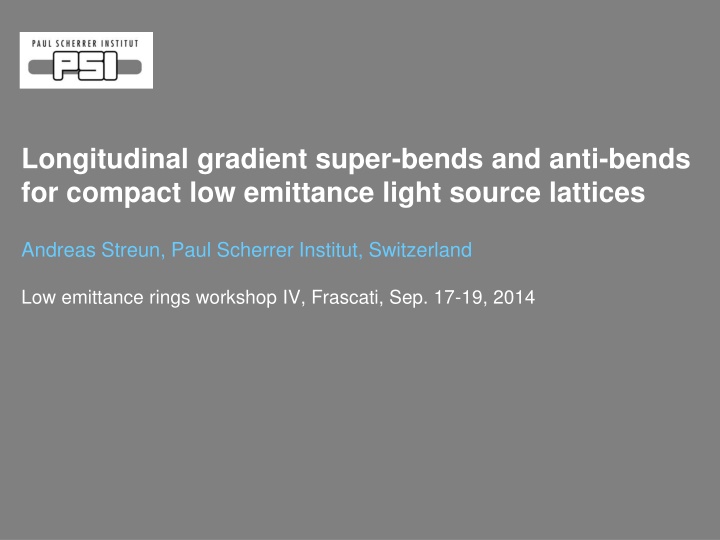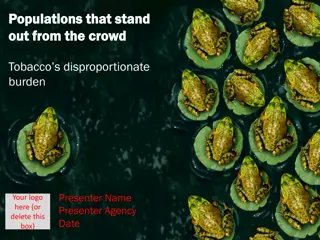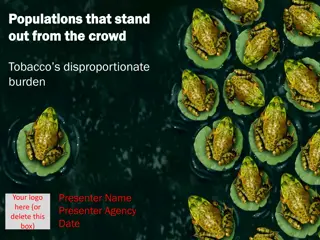
Compact Low Emittance Light Source Lattice Study: Gradient Bends & Anti-Bends
Explore longitudinal gradient super-bends and anti-bends for compact low emittance light source lattices. Detailed insights on paths to low emittance, TME cell, anti-bends, and more. Research presented by Andreas Streun from Paul Scherrer Institut, Switzerland at the Low Emittance Rings Workshop IV in Frascati.
Uploaded on | 0 Views
Download Presentation

Please find below an Image/Link to download the presentation.
The content on the website is provided AS IS for your information and personal use only. It may not be sold, licensed, or shared on other websites without obtaining consent from the author. If you encounter any issues during the download, it is possible that the publisher has removed the file from their server.
You are allowed to download the files provided on this website for personal or commercial use, subject to the condition that they are used lawfully. All files are the property of their respective owners.
The content on the website is provided AS IS for your information and personal use only. It may not be sold, licensed, or shared on other websites without obtaining consent from the author.
E N D
Presentation Transcript
Longitudinal gradient super-bends and anti-bends for compact low emittance light source lattices Andreas Streun, Paul Scherrer Institut, Switzerland Low emittance rings workshop IV, Frascati, Sep. 17-19, 2014
Contents Recall: paths to low emittance Recall: the TME cell The LGAB cell Longitudinal gradient bends Anti-bends Application to SLS upgrade Conclusions References AS & Albin Wrulich, Compact low emittance light sources based on longitudinal gradient bending magnets, submitted to NIM A AS, The anti-bend cell for ultralow emittance storage rings, NIM A 737 (2014) 148-154 A. Streun, Longitudinal gradient superbends and anti-bends LER-4, Frascati, Sep. 17-19, 2014 2/18
Recall: paths to low emittance ~ Cq I = 2 2 3 + ~ Cq I 2 I I = 2 5 [ m rad ] 2 4 xo I I ~ C 2 4 = 4 [ keV ] E I 2 Equilibrium beam parameters of a flat lattice xonatural horizontal emittance rms relative momentum spread, = p/p E energy loss per turn I2I3I4 I5 synchrotron radiation integrals ~ C ~ C = 60 keV constants = 13 13 . 3 83 10 m . 9 10 q A. Streun, Longitudinal gradient superbends and anti-bends LER-4, Frascati, Sep. 17-19, 2014 3/18
~ Cq I ~ Cq I ~ C = 2 2 = 2 = 3 + 4 5 [ m rad ] [ keV ] E I xo 2 2 I I I I 2 4 2 4 Optics I orbit curvature b =1/ = B/(p/e) dispersion s betatron amplitude = 3 | | min b ds H = [ + ( + 5 2 2 ) ' / ] H dispersion derivative hor. betafunction = transverse gradient k (k > 0 hor. foc.) C xo = 12 horizontal focus in each dipole many small dipoles of angle << 1 multibend achromat (MBA) lattice ~ MBA lattice without wigglers Power 2 I = 3 | | I b ds 2 3 3 = q 2 [ m rad ] F max ... b ds J 15 x damping wigglers (DW) F = 1 TME (theoretical minimum emittance) Damping = MBA & DW need space ! I b + = 2 ( 2 ) 1 2 b k ds I x J 4I 4 2 I 2 gradient bends for vertical focusing (bk < 0) A. Streun, Longitudinal gradient superbends and anti-bends LER-4, Frascati, Sep. 17-19, 2014 4/18
Recall: the TME cell Lowest emittance of a conventional lattice cell homogenous ( constant b ), short ( =bL ) bending magnet set o = o = 0 at bend center (symmetry); find minimum H ( o, o ) : theoretical minimum emittance (TME) for = = ~ C 3 L L q = = TME 2 1 [ m rad ] F TME o TME o xo J 24 12 15 2 15 x periodic symmetric cell: = = 0 at ends matching problem TME phase advance TME =284.5 2nd focus, useless long cell overstrained optics x y L, b A. Streun, Longitudinal gradient superbends and anti-bends LER-4, Frascati, Sep. 17-19, 2014 5/18
d Deviations from TME conditions = = = xo o o F r d TME xo TME o TME o Ellipse equations for emittance ) 1 + = 2 2 2 ( ( ) 1 d r F F 5 4 Cell phase advance r 6 r = tan ) 3 2 ( d 15 = 284.5 real cells: < 180 F ~ 3..6 How to get F < 1 and < 180 ? S. Leemann & AS, Perspectives for future light source lattices incorporating yet uncommon magnets, PR ST AB, 14, 030701, 844 (2011). A. Streun, Longitudinal gradient superbends and anti-bends LER-4, Frascati, Sep. 17-19, 2014 6/18
The LGAB cell Detuned TME cell vs. longitudinal-gradient/anti-bend cell both: angle 6.7 , E = 2.4 GeV, L = 2.36 m, x= 160 , y= 90 , Jx 1 TME:F = 3.4, = 990 pm LGAB: F = 0.69, = 200 pm x y x y dipole field quad field total |field| } at R = 13 mm longitudinal gradient bend anti-bend A. Streun, Longitudinal gradient superbends and anti-bends LER-4, Frascati, Sep. 17-19, 2014 7/18
Longitudinal gradient bends + ( + 2 2 ) ' = H = 3 b(s) = B(s)/(p/e) | ( | ) ( ) I b s s ds H 5 L Longitudinal field variation b(s) to compensate H (s) variation Beam dynamics in bending magnet Curvature is source of dispersion: Horizontal optics ~ like drift space: Assumptions: no transverse gradient (k = 0); rectangular geometry Variational problem: find extremal of (s) for = = 2 2 0 2 s ( ' ' ) ) ( ) ( ' s ) 1 ( ) s s b s s s + + ( 0 0 0 = too complicated to solve mixed products up to (4)in Euler-Poisson equation... use special function b(s) = f(s,{ak})with parameters {ak}: variational problem minimization problem for {ak} numerical optimization: find extremal; suggest functions f = | ) ' ' 3 functional with ( , , , ' ) ' ' min ( , , , ' | ' ' I f s ds f s H 5 L A. Streun, Longitudinal gradient superbends and anti-bends LER-4, Frascati, Sep. 17-19, 2014 8/18
Numerical optimization Results for half symmetric bend ( L = 0.8 m, = 8 , 2.4 GeV ) Half bend in N slices: curvature bi, length si Knobs for minimizer: {bi}, 0, 0 Objective: I5 ( or I5 / I2 ) Constraints: length: si = L/2 angle: bi si = /2 [ field: bi < bmax ] [ optics: 0 , 0 Results: hyperbolic field variation (for symmetric bend, dispersion suppressor bend is different) Trend: b0 , 0 0 , 0 0 optimized hyperbola fit homogeneous I I5contributions ] = = = hom 5 hom 2 hom / . 0 34 , / 5 . 2 / . 0 13 I I I I 5 2 A. Streun, Longitudinal gradient superbends and anti-bends LER-4, Frascati, Sep. 17-19, 2014 9/18
Analytical optimization Given function b(s) = f(s,{ak}), parameters {ak} I5/ 0, I5/ 0= 0 emittance & matching { I5/ ak} = 0 optimum parameters Useful simple functions for field profiles: high field magnets: hyperbola (parameters h, p) superbends hard X-ray photons from field peak! low field magnets: step function (parameter m) most simple design b = 0 ( ) b s + p 1 ( ) hs for 0 b s m 0 = ( ) b s for / 2 b m s L 1 numerical optimization results A. Streun, Longitudinal gradient superbends and anti-bends LER-4, Frascati, Sep. 17-19, 2014 10/18
Deviations from optimum matching Numerical optimization of field profile for fixed 0, 0 Emittance (F) vs. 0, 0 normalized to data for TME of hom. bend F = 1 F 0.3 F = 1 small (~0) dispersion at centre required, but tolerant to large beta function A. Streun, Longitudinal gradient superbends and anti-bends LER-4, Frascati, Sep. 17-19, 2014 11/18
Anti-bends General problem of dispersion matching: dispersion production in dipoles defocusing : > 0 Quadrupoles in conventional cell: dispersion is horizontal trajectory: quads treat and xin same way. over-focusing of horizontal beta function x insufficient focusing of dispersion striking example: the TME cell disentangle and x! use negative dipole: anti-bend kick = , angle out of phase with main dipole negligible effect on x , y Side effects on emittance: main dipole angle increase by 2| anti-bend located at large H H in total, still lower emittance A. Streun, Longitudinal gradient superbends and anti-bends dispersion: anti-bend off / on x y relaxed TME cell, 5 , 2.4 GeV, Jx 2 Emittance: 500 pm / 200 pm LER-4, Frascati, Sep. 17-19, 2014 12/18
Half quad anti-bend ~ Cq I Recall: emittance reduction via I4 get half emittance = 2 5 [ m rad ] xo I I 2 4 = I b + = 2 ( 2 ) 1 2 b k ds I x J 4I 4 2 I 2 2k >> b2, > 0 b > 0, k< 0 defocusing gradient bend need horizontal focusing at anti-bend location anyway (out of phase with main bend). convenient magnet design: anti-bend = half quadrupole b < 0, k> 0 focusing gradient anti-bend A. Streun, Longitudinal gradient superbends and anti-bends LER-4, Frascati, Sep. 17-19, 2014 13/18
Application to SLS upgrade Plans for an upgrade of the Swiss Light Source (SLS) SLS emittance now: 5500 pm M. Ehrlichman, First studies on a possible SLS upgrade, Wednesday 10:10 SLS constraints: 288 m, 12 straights, 2.4 GeV rather compact lattice ! LGAB-HMBA lattice hybrid multibend achromat incorporating longitudinal gradient bends and anti-bends 100 200 pm emittance: factor 50 25 improvement. hard X-rays (100 keV) from LG-superbend field peak. Dipole Flux [ph/mr^2/sec/0.1%bw] 1.4 T 2.95 T 5.00E+13 4.00E+13 5.7 T 3.00E+13 2.00E+13 SLS-1 normal bend SLS-1 superbend SLS-2 LG superbend 1.00E+13 0.00E+00 E 0 20 40 60 80 100 A. Streun, Longitudinal gradient superbends and anti-bends LER-4, Frascati, Sep. 17-19, 2014 14/18
a) most aggressive design anti-bend half quad hyperbolic LG superbend step-function LG bend ultra-low emittance: = 73 pm ! ( 18 m / 30 arc at 2.4 GeV ) feasible magnets, sufficient dynamic aperture quasi isochronous (MCF = ) and nonlinear too short bunches, insufficient energy acceptance large normalized chromaticities /Q = 3.9 / 4.3 A. Streun, Longitudinal gradient superbends and anti-bends LER-4, Frascati, Sep. 17-19, 2014 15/18
b) compromise design hyperbolic LG superbend homogeneous bends acceptable emittance: = 183 pm feasible magnets, sufficient dynamic aperture large MCF ( = + ) large normalized chromaticities /Q = 4.1 / 6.5 only partial exploitation of LGAB scheme bunch length & E-acceptance A. Streun, Longitudinal gradient superbends and anti-bends LER-4, Frascati, Sep. 17-19, 2014 16/18
c) negative alpha design strong anti-bends hyperbolic LG superbend = 500 acceptable emittance: = 162 pm large negative MCF ( = ) low normalized chromaticities /Q = 2.0 / 2.9 full exploitation of LGAB scheme: relaxed focusing. work in progress... A. Streun, Longitudinal gradient superbends and anti-bends LER-4, Frascati, Sep. 17-19, 2014 17/18
Conclusions Longitudinal gradient bends ... ... provide lower emittance than the TME for homogenous bends. ... offer the double use to provide low emittance and hard X-rays. ... can be described well by hyperbolae (high field) or step functions (low field). ... require very small dispersion at focus, ... but tolerate large values of horizontal beta function at focus. Anti-bends ... ... disentangle dispersion and horizontal beta function, ... are thus well suited to provide the matching for LG bends. ... introduce negative momentum compaction. The LGAB cell ... ... combines longitudinal gradient bends and anti-bends. ... offers a lattice solution for compact low emittance rings. A. Streun, Longitudinal gradient superbends and anti-bends LER-4, Frascati, Sep. 17-19, 2014 18/18



